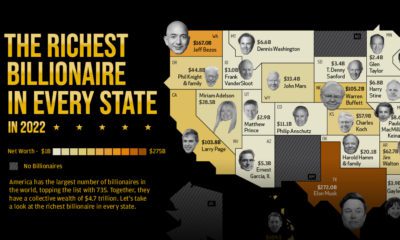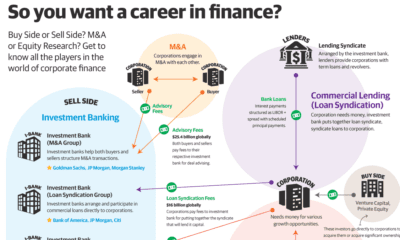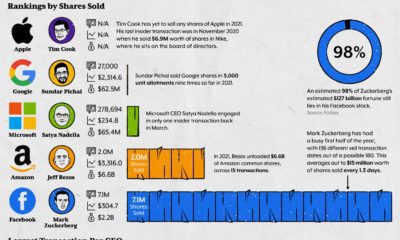Largest Bull Markets Understandably, this makes many people very nervous. Everyone remembers the mayhem of 2008 – and with stock prices at all-time highs, the fear of a market meltdown is a valid concern for many investors.
How to Become Unshakeable
Today’s infographic is from Tony Robbins, leveraging data and talking points from his #1 Best Selling book Unshakeable: Your Financial Freedom Playbook, which is now available on paperback. It leans on insights from the world’s top investors – like Ray Dalio and John Bogle – to present seven indisputable facts about market crashes, using clear patterns established over decades of data. By understanding these seven facts, you’ll be able to prepare for the recurring seasons of the financial market, including winter, and it will help give you an enormous edge over even many sophisticated and experienced investors.
Seven Indisputable Facts
Here are the seven facts that will free you from a fear of stock market crashes: Fact #1: On average, corrections happen once per year For more than a century, the market has seen close to one correction (a decline of 10% or more) per year. In other words, corrections are a regular part of financial seasons – and you can expect to see as many corrections as birthdays throughout your life. The average correction looks something like this:
54 days long 13.5% market decline Occurs once per year
The uncertainty of a correction can prompt people to make big mistakes – but in reality, most corrections are over before you know it. If you hold on tight, it’s likely the storm will pass. Fact #2: Fewer than 20% of all corrections turn into a bear market When the stock market starts tumbling, it can be tempting to abandon ship by selling assets and moving into cash. However, doing so could be a big mistake. You would likely be selling all of your assets at a low, right before the market rebounds! Why? Fewer than 20% of corrections turn into bear markets. Put another way, 80% of corrections are just short breaks in otherwise intact bull markets – meaning that selling early would make you miss the rest of the upward trend. Fact #3: Nobody can predict consistently whether the market will rise or fall The media perpetuates a myth that, if you’re smart enough, you can predict the market’s moves and avoid its downdrafts. But the reality is: no one can time the market. During the current nine year bull market, there have been dozens of calls for stock market crashes from even very seasoned investors. None of these calls have come true, and if you’d have listened to these experts, you would have missed the upside. – Warren Buffett Fact #4: The market has always risen, despite short-term setbacks Market drops are a very regular occurrence. For example, the S&P 500 – the main index that tracks the U.S. stock market – has fallen on average 14.2% at least one point each year between 1980-2015. Like winter, these drops are a part of the market’s seasons. Over this same period of time, despite these temporary drops, the market ended up achieving a positive return 27 of 36 years. That’s 75% of the time! Fact #5: Historically, bear markets have happened every three to five years In the 115 year span between 1900-2015, there have been 34 bear markets. But bear markets don’t last. Over that timeframe, they’ve varied in length from 45 days to 694 days, but on average they lasted about a year. Fact #6: Bear markets become bull markets Do you remember how fragile the world seemed in 2008 when banks were collapsing and the stock market was in free fall? When you pictured the future, did it seem dark and dangerous? Or did it seem like the good times were just around the corner and the party was about to begin? The fact is, once a bear market ends, the following 12 months can see crucial market gains. – John Templeton Fact #7: The greatest danger is being out of the market From 1996 through 2015, the S&P 500 returned an average of 8.2% a year. But if you missed out on the top 10 trading days during that period, your returns dwindled to just 4.5% a year. It gets worse! If you missed out on the top 20 trading days, your returns were just 2.1%. And if you missed out on the top 30 trading days? Your returns vanished into thin air, falling all the way to zero! – Tony Robbins on Last year, stock and bond returns tumbled after the Federal Reserve hiked interest rates at the fastest speed in 40 years. It was the first time in decades that both asset classes posted negative annual investment returns in tandem. Over four decades, this has happened 2.4% of the time across any 12-month rolling period. To look at how various stock and bond asset allocations have performed over history—and their broader correlations—the above graphic charts their best, worst, and average returns, using data from Vanguard.
How Has Asset Allocation Impacted Returns?
Based on data between 1926 and 2019, the table below looks at the spectrum of market returns of different asset allocations:
We can see that a portfolio made entirely of stocks returned 10.3% on average, the highest across all asset allocations. Of course, this came with wider return variance, hitting an annual low of -43% and a high of 54%.
A traditional 60/40 portfolio—which has lost its luster in recent years as low interest rates have led to lower bond returns—saw an average historical return of 8.8%. As interest rates have climbed in recent years, this may widen its appeal once again as bond returns may rise.
Meanwhile, a 100% bond portfolio averaged 5.3% in annual returns over the period. Bonds typically serve as a hedge against portfolio losses thanks to their typically negative historical correlation to stocks.
A Closer Look at Historical Correlations
To understand how 2022 was an outlier in terms of asset correlations we can look at the graphic below:
The last time stocks and bonds moved together in a negative direction was in 1969. At the time, inflation was accelerating and the Fed was hiking interest rates to cool rising costs. In fact, historically, when inflation surges, stocks and bonds have often moved in similar directions. Underscoring this divergence is real interest rate volatility. When real interest rates are a driving force in the market, as we have seen in the last year, it hurts both stock and bond returns. This is because higher interest rates can reduce the future cash flows of these investments. Adding another layer is the level of risk appetite among investors. When the economic outlook is uncertain and interest rate volatility is high, investors are more likely to take risk off their portfolios and demand higher returns for taking on higher risk. This can push down equity and bond prices. On the other hand, if the economic outlook is positive, investors may be willing to take on more risk, in turn potentially boosting equity prices.
Current Investment Returns in Context
Today, financial markets are seeing sharp swings as the ripple effects of higher interest rates are sinking in. For investors, historical data provides insight on long-term asset allocation trends. Over the last century, cycles of high interest rates have come and gone. Both equity and bond investment returns have been resilient for investors who stay the course.













